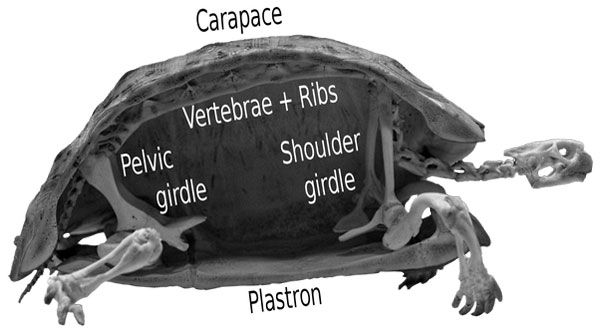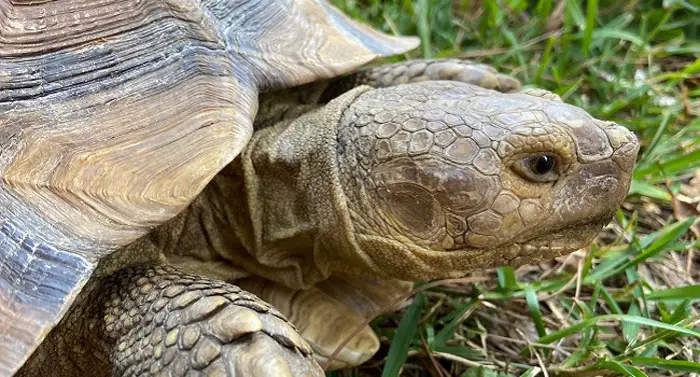Anatomy of a Tortoise: Basic Ideas about a Tortoise’s Physical Structure
Tortoises are one of the oldest living reptiles on the earth. They’re fascinating creatures but hugely misunderstood by many. Knowing the body structure of a tortoise could unbutton this confusion and clarify the misunderstanding.
So, what is the anatomy of a tortoise? In opposition to the misconception that tortoises’ shells are detached from their bodies, they are actually fused with the rib cage and spine of the tortoises. They have thick, strong legs to walk on dry land for long periods of time. As they look differently shaped from other animals, so are their bones and muscles.
In this guide, we’ll learn about various body parts of a tortoise and learn how they work. If you’re someone trying to learn about tortoise anatomy, well, you’re in the right place.
Anatomy of a Tortoise
Contents
Let’s talk about the anatomy of a tortoise now. We’ll start with the outside parts first and then discuss the insides.
1. Outside Parts of a Tortoise
We’re going to learn about the anatomical parts of a tortoise that are visible, meaning the outside parts.

Shell
A tortoise’s shell is the most prominent part of it. The top part of the shell is called the carapace, and the bottom one is called the plastron. Both of these parts are connected by a bridge to a tortoise’s body.
Contrary to a common misconception, a tortoise can feel its shell being touched as there are nerve endings on it.
Does a tortoise have an endoskeleton or exoskeleton?

They have both in fact. Tortoises have an outer shell covered with keratin and a bony structure on the inside. All their skeletal bones and shells are connected to create a single structure.
- The shell is made from a material called keratin, the same element we have in our nails.
- As a tortoise grows, it’ll have more and more layers of keratin over its old shell – making its shell thicker and heavier with time.
- However, it’s not correct to determine a tortoise’s age by checking its shell. The shape of the shell could be thin or thick quickly, depending on the tortoise’s diet and nutritional factors.
- A common misconception about a tortoise’s shell is that they’re a single piece of bone, which isn’t true.
- Underneath the shell, a tortoise has a few bones. The bones are covered by individual pieces of ring-like keratins, which are called scutes.
Carapace
In the carapace part of a tortoise, there are five scutes:
- The Nuchal – It’s the scute that sits above the head of a turtle.
- The Supracaudal – This scute sits right behind the tails, on the shell.
- The Vertebrals – It’s a vertical line of scutes which go straight from the head to the tails.
- The Marginals – These sit around the shell, in the corners.
- The Costals – These sit between the Marginals and the Vertebrals.
Plastron
And in the plastron, there are six pairs of scutes:
- The Gular
- The Humerals
- The Pectoral
- The abdominal
- The femoral
- The anal plastral scutes.
A plastron is smaller than a carapace since its shape is convex (curved outward) and has more surface area. Plastrons could be both concave (curved inward) and flat. Usually, males have concave-shaped plastrons, which allow them to mate with females with ease.
Head
A tortoise’s head is block-shaped with a beak on the front. On the head, it has two eyes that look a bit squinted. On the beak, there are two holes for its nose. The holes are called nares. While the nose holes are tiny, the tortoise’s sense of smell is very sensitive.
As a matter of fact, a tortoise uses its nose to find its food, mate, housing and even to smell the area it’s in.
A tortoise can retract its head inside its shell as its vertebrae are connected to the head and other bones. Their muscles are very flexible.
Ears
Tortoises have ears, but they lack any auricle (outside part of the ear) like humans or other animals do. The ears are located behind the eyes, on the back of their head. Similarly, the ears are covered with flaps and inside, there are eardrums and ear canals of each ear.

Misinformation about tortoises is that they have no ears. This fact has been popularized by many research papers throughout the years. The fact of the matter is they surely have ears, but they act differently from our ears.
Tortoises are less responsive to sounds, but they’re not really deaf. Sadly, we don’t have much information about their hearing as there hasn’t been enough research about the subject yet.
Teeth
Tortoises do not have teeth, but they have beaks. Their beaks are very strong and work as a good alternative to teeth. Usually, a tortoise’s diet consists of flowers, low-height vegetation, fruits, herbs, shrubs and grasses. With the beaks, tortoises can break their food down and grind them up smoothly.
Also, what a tortoise will eat depends on where it lives. As long as a tortoise can break food with its beak, it’ll be fine eating that food.

Legs
Unlike turtle legs, the legs of a tortoise aren’t webbed. They’re thick and straight, as tortoises are land creatures and need elephant-like legs to support their heavy weight. The legs have claws attached to them which help tortoises dig burrows effectively.
Eyes
Tortoises have good eyesight due to the fact that their eyes are placed at the sides of their head. But if we’re talking scientifically, there’s not much research done on the effectiveness of their eyes or the sensitivity of their vision.

Since they have all-around vision instead of binocular vision (two eyes facing in the same direction) like humans, they can see more of their surroundings.
It’s supposed that tortoises are able to detect movement well with their all-around eyes. However, as there’s a lack of research on their vision’s effectiveness, it’s hard to tell how fast or clearly they can detect movement.
Spine
Tortoises have spines. Their spines and rib cages are connected to their shells, hidden underneath the keratin structure. While a tortoise’s bones and muscles aren’t flexible as they’re fused with the shell, its tail, leg and head muscles are very strong and flexible.
Tails
Tortoises have tails where they have a vent called a cloaca in the end of the tails. They use the cloaca to pee, poo and for breeding.
Scales
Tortoises have scales that make their skin look a bit rough/uneven. This is actually not because only their skin is wrinkling, but also because of the scales that increase the harsh feeling of it.
2. Inside Parts of a Tortoise
Now let’s talk about the internal organs of a tortoise. Their insides are similar to other animals, actually. Nevertheless, let’s talk about them now.

Lungs
We expand and contract our rib cages to breathe through our lungs. The movement works as a mechanism to help our lungs inhale and exhale. A tortoise can’t do this because its spine is fused to its shell, which is inflexible.
But it has a different set of muscles to move its lung muscles, making its breathing as simple as ours. Tortoises along with turtles fall into the family of Chelonia, so their lungs are known as Chelonian lungs.
These are designed to hold breath for some time which can be helpful if a tortoise is underwater. Though, tortoises are never in water for long periods because they prefer land and dry places.
Bladder
As many tortoise species live in dry and arid areas where water is scarce, they have to spend days without water, occasionally. Their bladders can store water for a while when water becomes scarce until the tortoise finds a new source of water.
Other parts of a tortoise include kidneys, liver, intestines and other things needed for an animal. But they’re basically similar to those of other reptiles.
FAQs
Let’s talk about a few commonly asked questions about tortoises now.
No. They’re not colorblind, but their eyes are different from human eyes. Moreover, there’s not enough information about their vision and color perception in detail till now.
Yes. They have lungs as they’re land animals. They have interaction with water when drinking and in occasional bathing sessions. Other than these, tortoises don’t like water; thus, there’s no need for them to have gills.
Yes, they do. Their bones are fused with their shells, making their shells a solid structure.
Final Words
To be honest, what we discussed here isn’t enough to understand a tortoise inside-out. This animal is still largely misunderstood. Hopefully, in the near future, there’ll be more research on tortoises to learn about them better. When that happens, we’ll learn tortoise psychology, vision and touch sensitivity and other physical aspects well.
But hopefully, what we’ve discussed here should help you understand quite a lot about tortoises. They surely are fascinating creatures. By knowing about their anatomy, you’re now one of the few people with a better understanding of one of the least understood creatures.

